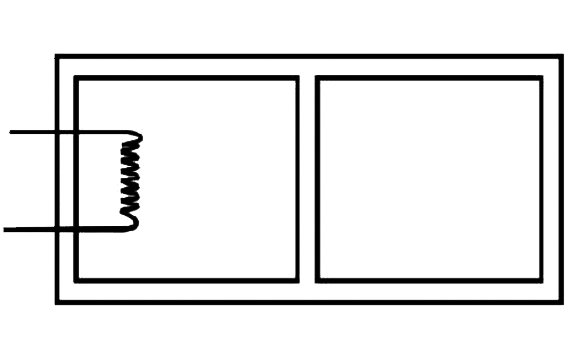One kg of a diatomic gas is at pressure of 8×104N/m2. The density of the gas is 4kg/m3. What is the energy of the gas due to its thermal motion?Solution in Gujrati
6×104J
7×104J
3×104J
5×104J
The correct Answer is:C
Energy of the diatomic gas 52nRT=52PV=52×8×104×14=5×104J
Topper's Solved these Questions
- GEOMETRICAL OPTICSBOOK - ALLEN CHAPTER - GEOMETRICAL OPTICSEXERCISE - EXERCISE - 05 (B)
58 Videos
- GEOMETRICAL OPTICSBOOK - ALLEN CHAPTER - GEOMETRICAL OPTICSEXERCISE - EXERCISE - 05 (B) (MCQ)
9 Videos
- GEOMETRICAL OPTICSBOOK - ALLEN CHAPTER - GEOMETRICAL OPTICSEXERCISE - EXERCISE - 04 (B)
15 Videos
- CURRENT ELECTRICITYBOOK - ALLEN CHAPTER - CURRENT ELECTRICITYEXERCISE - EX.II
66 Videos
- GRAVITATIONBOOK - ALLEN CHAPTER - GRAVITATIONEXERCISE - EXERCISE 4
9 Videos
Similar Questions
A vessel contains a mixture of one mole of oxygen and two moles of nitrogen at 300K. The ratio of the average rorational kinetic energy per O2 molecules to that per N2 molecules is
View SolutionLet ¯v,vrms and vp respectively denote the mean speed, the root-mean - square speed, and the most probable speed of the molecules in an ideal monoatomic gas at absolute temperature T. The mass of a molecule is m:-
View SolutionThe rectangular box shown in Fig has partition which can slide without friction along the length of the box. Initially each of the two chambers of the box has one mole of a mono-atomic ideal gas (λ=5/3) at a pressure P0, volume V0 and temperature T0. The chamber on the left is slowly heated by an electric heater. The walls of the box and the lead wires of the heater is negligible. The gas in the left chamber expands pushing the partition until the final pressure in both chambers becomes 243P0/32. Determine (i) the final temperature of the gas in each chamber and (ii) the work done by the gas in the right chamber.

View SolutionIn the Bohr's model of hy drogen atom, the electron moves around the nucleus in a circular orbit of radius 5×10−11m. Its time period is 1.5×10−16s. The current associated with the electron motion is:-
View SolutionAssertion : The difference in the value of acceleration due to gravity at pole and equator is proportional to square of angular velocity of earth.
Reason : the value of acceleration due to gravity is minimum at the equator and maximum at the pole.
View SolutionOne kg of a diatomic gas is at pressure of 8xx10^4N//m^2 . The density of the gas is 4kg//m^3 . What is the energy of the gas due to its thermal motion?
View SolutionCalculate the kinetic energy of one gram mole of gas at NTP. Density of gas = 0.178 kg m^(-3) at NTP. Its molecular weight = 4. Density of mercury = 13.6 xx 10^(3) kg m^(-3) .
View SolutionTwo kg of a monoatomic gas is at a pressure of 4 xx 10^(4) N//m^(2) . The density of the gas is 8 kg//m^(3) . What is the order of energy of the gas due to its thermal motion ?
View Solutionएक किग्रा द्वी-परमाणुक गैस 8×104न्यूटन/मीटर2 दाब पर है। गैस का घनत्व 4किग्रा/मीटर3 है। गैस की उष्मीय गति के कारण गैस की ऊर्जा है:
View SolutionOne kg of a diatomic gas is at a pressure of 8×104Nm−2 the density of the gas if 4kg/mg .What is the energy of the gas due to its thermal mole
View Solution2 किग्रा एकपरमाणुक गैस 4×104N/m2 के दाब पर है, गैस का घनत्व 8kg/m3 है। इस गैस में उष्मीय गति के कारण ऊर्जा की परिमाण कोटि होगी
View SolutionThe r.m.s. velocity of molecules of a gas of density 4kg /m3 and pressure 1.2×105N/m2 is
View SolutionTwo kg of a monoatomic gas is at a pressure of 4×104N/m2. The density of the gas is 8kg/m3. What is the order of energy of the gas due to its thermal motion ?
View SolutionOne kg of a diatomic gas is at pressure of 8xx10^4N//m^2 . The density of the gas is 4kg//m^3 . What is the energy of the gas due to its thermal motion?
View SolutionOne kg of a diatomic gas is at a pressure of 8×104N/m2 . The density of the gas is 4kgm3 . What is the energy of the gas due to its thermal motion?
View SolutionOne kg of a diatomic gas is at pressure of 8xx10^4N//m^2 . The density of the gas is 4kg//m^3 . What is the energy of the gas due to its thermal motion?
View Solution
